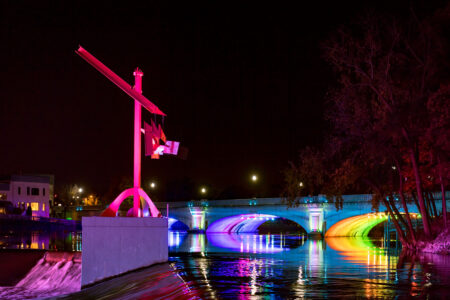The importance of providing reprieve through public art
“Art in public spaces can be a ray of hope amid a dark day or even just the day to day. It also connects people in a disconnected world, where people who may not normally come together just to say, ‘that’s beautiful!’” – Cassi Graber
In an unsuspecting location under the bridge, following the winding pathway towards the playground surrounds a vast mural in Howard Park, highlighting each season in whimsy. There is no obvious force for visitors to interact with it, but the mural draws both young and old for photos and reflection daily.
It is not the only art piece that attracts beauty and storytelling within the confines of South Bend. Dedicated back in 2017 and nestled between two downtown buildings stands a stunning bronze statue of Father Hesburgh and Martin Luther King, Jr. holding hands, frozen in time. Another longstanding piece can be spotted in the middle of the river behind the Century Center. Erected in 1980, the orange Mark di Suvero sculpture, “Keepers of the Fire” pays homage to the Potawatomi Indians who migrated to South Bend and stands as a symbol of reunion, return and remembrance.
Public art regardless of the medium, has become an increasingly popular way to dress up alleyways, storefronts and green spaces throughout various cities, big and small in recent years. So, why is it important for the wellbeing of a community?
There are many reasons why art has proven to be an effective reprieve for so many. Public art can provide two necessary components to any vital neighborhood: inclusivity and accessibility.
“So many people are going through hard things in all walks of life,” said Cassi Graber, artist of the Howard Park playground mural. “Art in public spaces can be a ray of hope amid a dark day or even just the day to day. It also connects people in a disconnected world, where people who may not normally come together just to say, ‘that’s beautiful!’”
Regardless of where it may be located, art can capture the eye and the mind in a single second of a passerby. It can speak to the soul regardless of race, background, or social status. It has the capacity to singlehandedly put a city on the map or simply improve the quality of life in a neighborhood.
History has shown the effects of art in a community as well. After the end of World War II, over 40 sculptures were commissioned to bring Germany’s public spaces back to life, reinvigorating dilapidated towns that had once seen the horrors of war. These statues soon became a source of optimism and revitalization for a once-broken community. It has been proven time and again – art can transform human emotions and serve as a source of hope, regardless of location.
“Art, in my opinion, should be created to bring life, hope, and freedom to the broken and hurting,” said Graber. “I especially love to create art for children. They see the beauty in the simplicity of life, which I believe is the key to joy of living no matter your age!”

